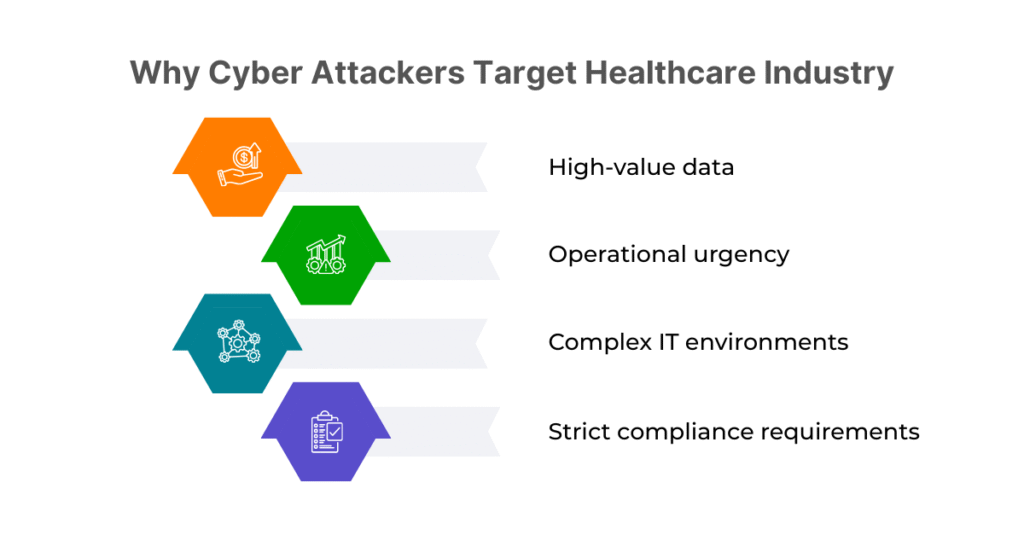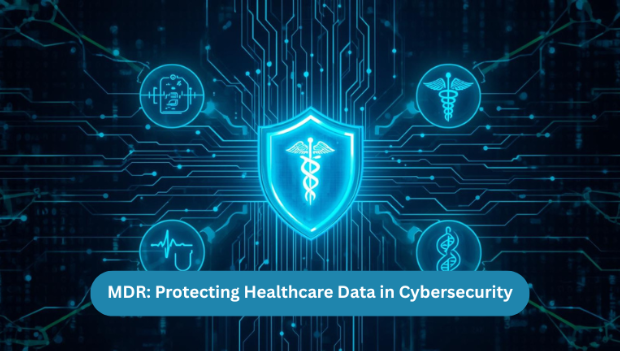It was in the year 2021, when healthcare as an industry started to embrace digital transformation. Many factors played catalysts to the change that was taking place. By 2025, digital patient records, telemedicine and cloud-based health applications have become common and penetrated deep across markets of the world. This digital shift, experts believe, has brought efficiency, innovation and transformation. However, in the context of cybersecurity, a vast number of new risks have been unearthed. Plus, the healthcare industry is a lucrative target for cybercriminals.
Managed Detection & Response (MDR) has emerged as the fulcrum for securing healthcare industry. Of course, because of its advanced features which help in protecting sensitive data, maintaining compliance and also ensuring uninterrupted healthcare operations. You might ask, “What differentiates MDR?” and experts will say three things: continuous monitoring, proactive threat hunting and rapid incident response. In short, MDR often is the difference between resilience and disaster for healthcare organizations.
- Why Healthcare Is Always a Prime Target
- What Is Managed Detection & Response?
- The Role of MDR in Healthcare Data Transitions
- How Cybersecurity Helps Healthcare Industry: A Possible Scenario
- MDR Security vs. Traditional Security Tools
- Key Benefits of MDR for Healthcare
- Steps to Incorporate MDR Into Healthcare Cybersecurity
- Conclusion
Why Healthcare Is Always a Prime Target
If you understand the mindset of cybercriminals, you will easily know why. Threat actors prefer large amounts of data. Plus, money is always an attraction. And also, the vulnerabilities prevalent in this industry, which are opportunities for hackers. This is the reason why healthcare security incidents hit headlines often.

- High-value data: Patient records are worth more than credit card details on the dark web, making them prime targets for cybercriminals.
- Operational urgency: Hospitals and clinics can’t afford downtime; attackers know this and use ransomware to pressure organizations into paying quickly.
- Complex IT environments: Mergers, new health apps, cloud migration, and IoT-enabled medical devices all expand the attack surface.
- Strict compliance requirements: Regulations like HIPAA in the U.S. and GDPR in Europe demand robust data protection, and violations carry steep penalties.
Managed Detection & Response that combine technology, people and processes, providing real-time visibility and action, is thus the need of the hour. Find out more about MDR in the next section.
What Is Managed Detection & Response?
There are scores of definitions you will find about Managed Detection & Response. But in the outset, you should understand that MDR is a service unlike tools like EDR and XDR. In addition, Managed Detection & Response service providers or vendors include advanced monitoring technologies, skilled security analysts and threat hunters. The aim is to detect, investigate and respond to threats around the clock (24/7).
Few major features that define MDR solution:
- 24/7 monitoring of networks, endpoints, and cloud environments.
- Threat intelligence integration to spot emerging risks.
- Proactive hunting to identify hidden threats that automated tools may miss.
- Incident response support to contain and neutralize attacks quickly.
- Detailed reporting to support compliance audits and risk management.
MDR ensures that when (not if) an attack occurs, it is identified and stopped before causing damage. That’s the capability which changes the game for security teams and organizations.
The Role of MDR in Healthcare Data Transitions
If you see, healthcare organizations are always on the move with their data transitions. From legacy systems to cloud or rolling out new patient-facing applications. And if that’s not the case you will hear about consolidating records after a merger. Each of these transitions opens doors for cyber attackers. A misconfiguration, a gap in monitoring or an overlooked vulnerability.
Here’s where MDR steps in:
- Visibility Across Hybrid Environments
Healthcare often operates in a mix of on-premises and cloud systems. MDR provides unified visibility, ensuring that no blind spots exist during the transition. - Proactive Threat Detection
Cybercriminals frequently exploit transitional periods when security teams are stretched thin. MDR services use continuous monitoring and MDR security analytics to spot unusual activity before it escalates. - Compliance Assurance
Regulations require secure handling of patient data during transitions. MDR helps organizations demonstrate due diligence by maintaining logs, reports, and evidence of ongoing monitoring. - Rapid Response
In the event of an incident, MDR ensures that threats are contained swiftly, minimizing downtime and preventing data loss. For hospitals, this can literally save lives.
How Cybersecurity Helps Healthcare Industry: A Possible Scenario
Assume you are running a hospital. Your security leader decides to migrate the patient records system containing extensive data to the cloud. Now there are enough cloud misconfigurations and security challenges. However, your IT team could not test this application due to lack of time or resources.
During this transition process, attackers launch a ransomware campaign, encrypting data and demanding payment from you.
With Managed Detection & Response service, the suspicious activity would have been flagged early, assisting security teams to isolate the affected systems and protect patient records. What’s more, no ransom and no business disruption.
This shows the importance of MDR, and it reveals how it is directly connected to your business.
MDR Security vs. Traditional Security Tools
Are your investments in traditional security tools enough? Or do you need to acquire MDR services which includes advanced security tools? The table below should make the answer clear.
| Traditional Tools | Managed Detection & Response |
| Reactive—alerts after compromise | Proactive—hunts for threats before damage occurs |
| Limited to known signatures | Uses threat intelligence and behavior analysis |
| Requires in-house expertise | Provides access to skilled security analysts |
| Focus on prevention | Emphasis on detection, response, and resilience |
Healthcare organizations, especially small to mid-sized ones, rarely have the internal resources to provide 24/7 coverage. MDR fills that critical gap.
Key Benefits of MDR for Healthcare
Here are some key benefits of Managed Detection & Response when it comes to healthcare
- Round-the-clock protection: Ensures constant monitoring, even during nights, weekends, or staff shortages.
- Faster incident response: Cuts down mean time to detect (MTTD) and mean time to respond (MTTR).
- Cost efficiency: Outsourcing advanced capabilities is often more affordable than building an in-house Security Operations Center (SOC).
- Enhanced compliance posture: Continuous logs and reports simplify audits and demonstrate proactive risk management.
- Business continuity: By minimizing disruptions, healthcare providers can keep patient services running without compromise.
Steps to Incorporate MDR Into Healthcare Cybersecurity
So, if you are convinced of implementing MDR into your cybersecurity program, how can you about it? Here is a step-by-step guide:
- Assess Current Security Posture
Conduct an initial review of vulnerabilities, gaps, and compliance requirements. - Define Clear Objectives
Identify what you want MDR to achieve—reduced risk, compliance assurance, or faster response times. - Select a Reliable MDR Provider
Choose providers with healthcare-specific expertise and proven track records. Consider services like Managed Detection & Response Services that align with your operational needs. - Integrating with Existing Tools
MDR works best when integrated with your current EHR systems, cloud platforms, and security infrastructure. - Continuous Review and Optimization
Cybersecurity is dynamic. Regularly review MDR reports and adapt strategies as new threats emerge.
Conclusion
Healthcare digitization is transformative, saving many lives. Therefore, technology adoption is only going to increase from hereon. But what about the risks it leaves behind? The use of security services like Managed Detection & Response is thus a must-have for organizations handling data transitions. Plus, Managed Detection & Response helps in meeting compliance standards.
For healthcare organizations, it is high time to strengthen defenses. MDR should be a priority in boardroom discussions. Plus, it should be seen as a strategic investment in resilience, trust and long-term success. Learn more about effective cybersecurity strategies with trusted partners like CyberNX.
